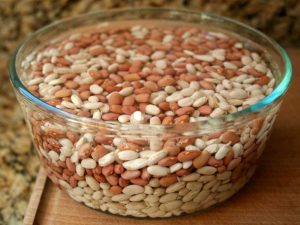Beans
This is one of a series of articles on food written by David Murray (see the full list on the right hand sidebar).
 Beans, beans, the magical fruit …
Beans, beans, the magical fruit …
Well, if you activate your beans the rest of the song doesn’t make much sense!
Beans are renowned for making you gassy, but that needn’t be the case! Learning how to activate your beans will rid them of the anti-nutrients and phytic acid that plays havoc with your digestive system and causes health issues, such as the dreaded flatulence.
But why bother? Activating beans takes about 24 hours. To do it right, you have to be organised. But being organised has its rewards.
Phytic acid is the Big Nasty in your beans. It binds with minerals in your food, such as calcium, magnesium and iron, preventing your body from absorbing them. Essentially, phytic acid raids your food and digestive system for minerals and then … passes through. Like a thief in the night.
But it’s not a smooth criminal. In fact, it’s more of a saboteur! In addition to causing mineral deficiency, regular consumption of phytic acid irritates your intestines, reduces the effectiveness of your immune system, causes tooth decay and bone loss, and even skin irritation. In children it’s worse, affecting physiological development.
Get rid of it!
But it’s not the only culprit. Beans also hold oligosaccharides. Other than sounding long and complex, this sugar is actually long and complex. And our bodies lack the enzyme to break them down. We just don’t know what to do with them.
Our bodies aren’t prepared for this!
And then there’s lectins. Lectins attached themselves to the lining of your small intestines. From there, they prevent your body letting nutrients into your bloodstream. Why is that bad? It means your organs aren’t getting the materials they need!
Oh my! What will you do?
It’s simple. Activate your beans. Even if you don’t eat them very often, you’ll be eating a more nutritious meal. And if you eat them all the time, you’ll be saving yourself from some digestive distress and long-term complications.
Oh, PLEASE tell me how!
For beans, the process is simple. It just takes time. The general rule of thumb is to soak your beans for a total of 24 hours. It’s best to break this up into three consecutive soakings, making sure to rinse the beans in between and replace the water each time.
Now, you’ll want to be using a glass or ceramic bowl for your soaking. Anything but plastic. For the first soaking the water should be hot. Not boiling, but hot. Somewhere around 50 degrees Celsius. If you have access to it, filtered water is also your best bet. Now, put the beans in the bowl first and then top with your hot water until it is about an inch above the beans.
Now comes the hard part: wait. Wait for eight hours. Go to sleep. Go to work. Go do something else. Just give it eight hours.
If you’re around, keep an eye on your beans. They might soak up some water and if they do, all you need to do is top it up again.
BEEP BEEP BEEP!
The timer you set is now going off. Time to rinse and repeat! This time there’s no need to use hot water. Room temperature is your best bet. Set that alarm again and you’re good to go!
Once more with the beeping, and once more with the rinse and repeat.
WAIT A MOMENT!
This is the last soaking. Now you need to ask yourself a question. The cooking process removes 50% of the phytic acid anyway, so if that’s not a concern for you just go on ahead. But if you want to lower that percentage even more, this time when you set your beans to soak you can add an acid medium. Namely, baking soda. But be warned! Soaking our beans with baking soda will mean that when you come to cook them, you can half the time. Great for larger beans, not so great for smaller, softer beans. They will go mushy. But this part is up to you. It’s an optional extra.
So, whatever you decide, give them another eight hours.
Perfect!
This is a pretty traditional method of food preparation. It used to be commonplace. In fact, beans were never really eaten unless they’d been activated or fermented in some way. I guess we’ve just lost touch with our food.
What a shame. There’s so much more to it than the supermarket brands. But as far as they’re concerned, the less we know the better.
